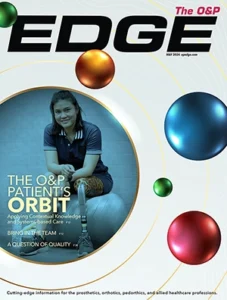A team of Griffith University, Southport, Australia, researchers have won the $50,000 mobility prize in the 2021 Bionic Queensland Challenge for their innovation to monitor osseointegrated (OI) bionic-limb stability.
Laurent Frossard, PhD, Menzies Health Institute Queensland, David Saxby, PhD, the School of Health Sciences and Social Work, and their team are working toward a proof-of-concept of a medical device called Thomax 2.0 that integrates state-of-the-art wearable loading sensors and personalized computational neuromusculoskeletal models to test a digital twin of the residual limb during load bearing exercises.
Current problems with OI prostheses include implant loosening, stability loss, and infection that can seriously impede daily usage of the prosthesis and quality of life.
“If the loading isn’t right, the bone doesn’t grab the metal and the implant fails to stay in their body,” Saxby said. “Then [patients] are likely to experience other types of complications like infections, possibly give it up, and return to a socket, or they are going to have other types of complication.”
“The Thomax 2.0 is designed to help rehabilitation work more effectively and safely by measuring the loading stress of a prosthesis on the stump of a limb in real-time,” Frossard said.
A member of the team, Caroline Graydon, who has an OI implant, said, “The loading has to be gradual to give your bone time to adhere to the implant. So, the amount of weight I put through my right residual limb is equal to the weight I put through my left residual limb. Without this, I wouldn’t be able to walk.”
Greater safety, mobility, and less infection are expected with the device designed to achieve bionic implant integration that enables pain-free and efficient rehabilitation exercises.
The Bionics Challenge 2021 is a Queensland-led competition with national and state-level prizes for bionic discoveries to propel advanced healthcare solutions for those living with road accident trauma, chronic conditions, diseases, and disabilities.
Findings from the team’s research, “Load applied on osseointegrated implant by transfemoral bone-anchored prostheses fitted with state-of-the-art prosthetic components,” was published in Clinical Biomechanics.
Editor’s note: This story was adapted by materials provided by Griffith University.

Saxby, Frossard, and Graydon.
Photograph courtesy of Griffith University.




